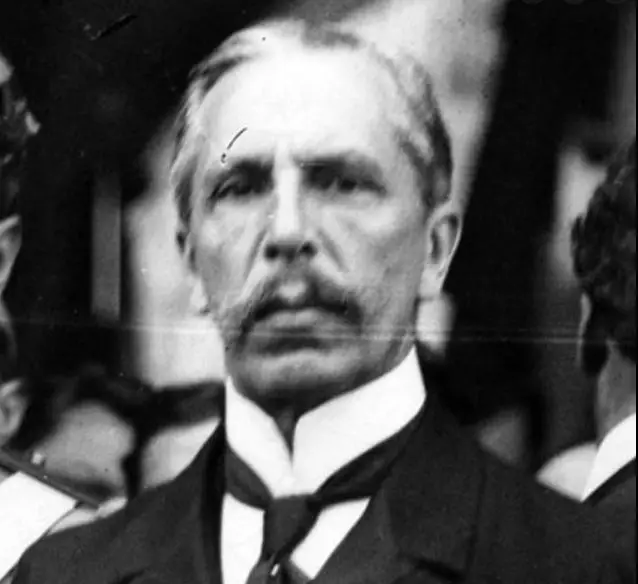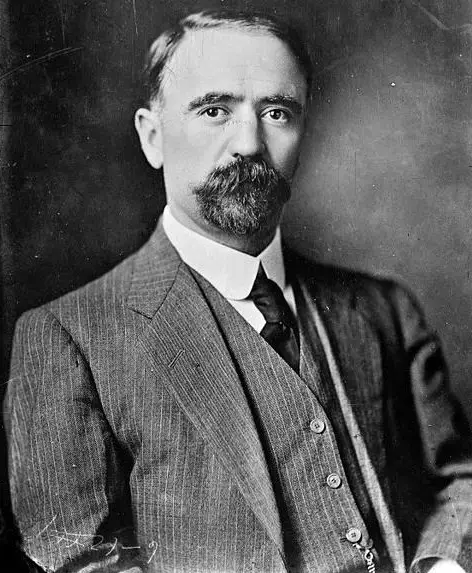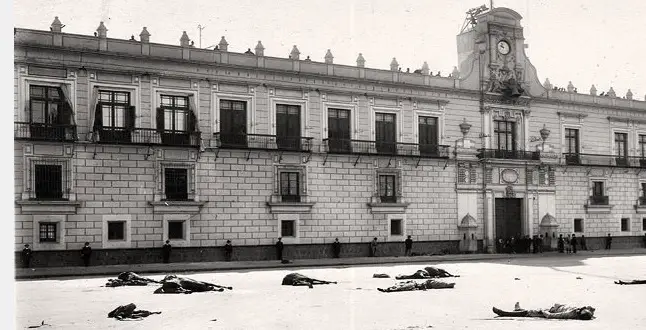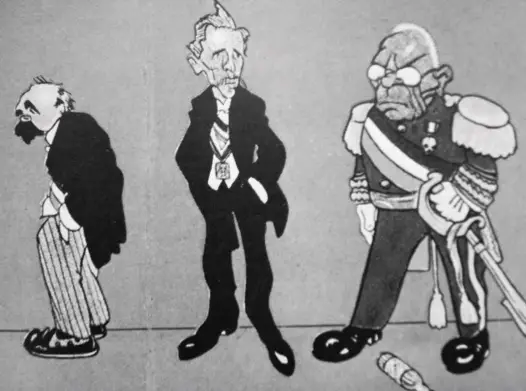Podcast: Play in new window | Download
Subscribe: Apple Podcasts | RSS
On April 13, 2002 Venezuelan president Hugo Chávez was overthrown in a coup and taken prisoner. Chávez’ vice president, Diosdado Cabello, was immediately sworn in as Venezuela’s president. In his swearing-in ceremony, Cabello proclaimed that he would serve as head of state until Chávez could be restored to power. Chávez was released from prison a few hours later thus making Cabello’s presidency the shortest in recent memory. Cabello’s brief term did not make the Guinness Book of World Records, however. The honor for the shortest term as head of state in the history of the world belongs to Mexico’s 38th president, a man named Pedro Lascuráin Paredes, who held on to power for all of 45 minutes. The day this took place was February 19, 1913 – in the midst of the Mexican Revolution – and is often referred to in the history books as “The Day of Three Presidents.”
 So, who was this 45-minute president and what were the circumstances around his short term in office? His full name was Pedro José Domingo de la Calzada Manuel María Lascuráin Paredes and he was born in an area of what is now Mexico’s Federal District called Rancho la Romita on May 8th 1856. Today, Rancho la Romita is known as Colonia Roma and is now a part of Mexico City that has experienced much gentrification and revitalization in the 21st Century. The Lascuráin name is Basque, and Pedro Lascuráin’s Basque ancestors came to Mexico right before Mexican Independence in the early 1800s. His maternal ancestry – the Paredes side – goes back many generations to the early days of New Spain. That branch of Lascuráin’s family tree bought huge tracts of land in Rancho la Romita early on from the Counts of Miravalle, who originally purchased the land from Hernán Cortés, the great conquistador himself. The land on which Colonia Roma now sits was once in a shallow part of Lake Texcoco immediately to the west of the Aztec capital of Tenochtitlán, with several islands in it, with one of the islands home to the Nahua village of Aztacalco. In colonial times when the lake dried up and the indigenous village deteriorated, the Spanish moved in and established themselves. Now, the area is known for its urban hipster feel with its modern cafes, edgy boutiques and throbbing neon discotheques. In the 19th Century the Lascuráin-Paredes family slowly sold off their holdings to wealthy Mexico City residents who wanted to escape the crumbling old colonial core of the city and because of this, the Lascuráin-Paredes family accumulated great wealth. An interesting note here, President Pedro Lascuráin is related to another Mexican president who hailed from the same Lascuráin-Paredes line from Colonia Roma, Mexico’s 15th president, Mariano Paredes y Arrellaga, who resigned at the beginning of the Mexican-American War in 1846.
So, who was this 45-minute president and what were the circumstances around his short term in office? His full name was Pedro José Domingo de la Calzada Manuel María Lascuráin Paredes and he was born in an area of what is now Mexico’s Federal District called Rancho la Romita on May 8th 1856. Today, Rancho la Romita is known as Colonia Roma and is now a part of Mexico City that has experienced much gentrification and revitalization in the 21st Century. The Lascuráin name is Basque, and Pedro Lascuráin’s Basque ancestors came to Mexico right before Mexican Independence in the early 1800s. His maternal ancestry – the Paredes side – goes back many generations to the early days of New Spain. That branch of Lascuráin’s family tree bought huge tracts of land in Rancho la Romita early on from the Counts of Miravalle, who originally purchased the land from Hernán Cortés, the great conquistador himself. The land on which Colonia Roma now sits was once in a shallow part of Lake Texcoco immediately to the west of the Aztec capital of Tenochtitlán, with several islands in it, with one of the islands home to the Nahua village of Aztacalco. In colonial times when the lake dried up and the indigenous village deteriorated, the Spanish moved in and established themselves. Now, the area is known for its urban hipster feel with its modern cafes, edgy boutiques and throbbing neon discotheques. In the 19th Century the Lascuráin-Paredes family slowly sold off their holdings to wealthy Mexico City residents who wanted to escape the crumbling old colonial core of the city and because of this, the Lascuráin-Paredes family accumulated great wealth. An interesting note here, President Pedro Lascuráin is related to another Mexican president who hailed from the same Lascuráin-Paredes line from Colonia Roma, Mexico’s 15th president, Mariano Paredes y Arrellaga, who resigned at the beginning of the Mexican-American War in 1846.
Pedro Lascuráin, like many sons of the wealthy or noble classes in Mexico and Europe at the time, went to law school. He had an end goal of becoming a magistrate or serving some other public function with his education and connections. In 1880, Lascuráin graduated from Mexico City’s Escuela Nacional de Jurisprudencia, or, in English, the National School of Jurisprudence. Many years later this school would become the law school of the National Autonomous University of Mexico, or UNAM. He worked as a lawyer during the presidency of Porfirio Díaz, and during the later years of the Porfiriato Lascuráin became mayor of Mexico City. When he assumed the office of mayor in 1910, tensions were high throughout the country, and Mexico was on the eve of the Revolution.
 While Lascuráin’s family thrived under the rule of the dictator Porfirio Díaz, Lascuráin supported Francisco I. Madero during the 1910 presidential elections. Madero, who had no political experience, had widespread support throughout many sectors of Mexican society because he wanted an end of the reign of Porfirio Díaz and desired to bring modern democratic reforms to Mexico. The Madero family at the time of the 1910 elections was worth 30 million pesos, the equivalent of 500 million US dollars in today’s money. Madero was well-bankrolled and well-connected. Fearing disruption of the elections, President Díaz had Madero arrested and sent to a prison in San Luis Potosí. Madero was off the ballot and Porfirio Díaz won the 1910 election, supposedly by a landslide, and was eager to start his 8th term as president. Madero and his supporters alleged fraud, and while in prison Madero came up with the Plan de San Luis Potosí declaring the elections null and void and calling for revolution if Díaz did not resign. Under severe pressure from many sides, Díaz eventually did resign, effective May 31, 1911, and elections were held in November of that year. Madero was the frontrunner and eventually won the election to become Mexico’s 37th president. During Madero’s rise to power, Lascuráin gave the new leader his full support and was heartily rewarded by Madero.
While Lascuráin’s family thrived under the rule of the dictator Porfirio Díaz, Lascuráin supported Francisco I. Madero during the 1910 presidential elections. Madero, who had no political experience, had widespread support throughout many sectors of Mexican society because he wanted an end of the reign of Porfirio Díaz and desired to bring modern democratic reforms to Mexico. The Madero family at the time of the 1910 elections was worth 30 million pesos, the equivalent of 500 million US dollars in today’s money. Madero was well-bankrolled and well-connected. Fearing disruption of the elections, President Díaz had Madero arrested and sent to a prison in San Luis Potosí. Madero was off the ballot and Porfirio Díaz won the 1910 election, supposedly by a landslide, and was eager to start his 8th term as president. Madero and his supporters alleged fraud, and while in prison Madero came up with the Plan de San Luis Potosí declaring the elections null and void and calling for revolution if Díaz did not resign. Under severe pressure from many sides, Díaz eventually did resign, effective May 31, 1911, and elections were held in November of that year. Madero was the frontrunner and eventually won the election to become Mexico’s 37th president. During Madero’s rise to power, Lascuráin gave the new leader his full support and was heartily rewarded by Madero.
On April 10, 1912, Pedro Lascuráin became part of President Madero’s cabinet, appointed as Foreign Minister. Lascuráin’s position as Foreign Minister was a difficult job, mostly because he had to deal with US Ambassador to Mexico, Henry Lane Wilson. Wilson was a career diplomat who was appointed to the post by American president William Howard Taft in 1909, during the final years of the reign of Porfirio Díaz. The US saw the long Díaz dictatorship as stable and supportive of US interests, and Ambassador Wilson did not like the new administration under Mexico’s new president, Francisco Madero. Ambassador Wilson began a disinformation campaign against Madero using his sources in the Associated Press back home and other sources in the English-language press in Mexico to portray Madero as an incompetent and someone who did not have the best interests of the US at heart. As Mexican foreign minister Pedro Lascuráin was caught in the middle and served as the unfortunate point man between the Madero regime and the Americans.
 February 9, 1913, was the beginning of what Mexican history books call La Decena Trágica, or in English, “The Ten Tragic Days.” Rebel forces opposing the new Madero regime, led by the nephew of Porfirio Díaz, Félix Díaz, and others, created an illusion of chaos with the ultimate end of forcing Madero to resign. Bombs went off sporadically throughout Mexico City. Random organized gunfire erupted in the streets. Ordinary citizens were displaced from their homes and caught in the crossfire. It was the textbook definition of what political scientists call strategia della tensione or “strategy of tension” whose purpose is to create a general feeling of insecurity in the population and make people seek security in a strong government. The rebel chaos was supported by the American Ambassador Henry Lane Wilson, who some historians believe was the true architect of the scheme. The head of the Mexican army, Victoriano Huerta, who once supported the Madero government, defected to the rebel side. On February 18, 1913, President Madero and his cabinet were captured by the military and held under house arrest at the National Palace. Pedro Lascuráin was the one who convinced Madero to resign because he told the president he would be executed if he didn’t concede to the demands of the rebels. This set off a strange set of events.
February 9, 1913, was the beginning of what Mexican history books call La Decena Trágica, or in English, “The Ten Tragic Days.” Rebel forces opposing the new Madero regime, led by the nephew of Porfirio Díaz, Félix Díaz, and others, created an illusion of chaos with the ultimate end of forcing Madero to resign. Bombs went off sporadically throughout Mexico City. Random organized gunfire erupted in the streets. Ordinary citizens were displaced from their homes and caught in the crossfire. It was the textbook definition of what political scientists call strategia della tensione or “strategy of tension” whose purpose is to create a general feeling of insecurity in the population and make people seek security in a strong government. The rebel chaos was supported by the American Ambassador Henry Lane Wilson, who some historians believe was the true architect of the scheme. The head of the Mexican army, Victoriano Huerta, who once supported the Madero government, defected to the rebel side. On February 18, 1913, President Madero and his cabinet were captured by the military and held under house arrest at the National Palace. Pedro Lascuráin was the one who convinced Madero to resign because he told the president he would be executed if he didn’t concede to the demands of the rebels. This set off a strange set of events.
According to the 1857 Constitution of Mexico, the line of succession of the presidency worked this way: If the president resigned or died, the vice-president would take control of the country. If the same happened to the VP, power would pass to the Attorney General of Mexico. The next in line of succession after the Attorney General was the Foreign Minister, the post that Pedro Lascuráin held at the time of the coup. The next in line of succession if the Foreign Minister died or resigned would be the Interior Secretary. On February 19, 1913, General Huerta forced Madero  to resign the presidency at gunpoint. At the same time the general also ousted Vice-President José María Pino Suárez and Attorney General Adolfo Valles Baca. This left Pedro Lascuráin as the most senior cabinet minister still in office. To give the coup an air of legitimacy, Pedro Lascuráin was then formally sworn in as president. As the 38th President of Mexico, Pedro Lascuráin accomplished only two things: He named General Victoriano Huerta his Interior Secretary and then resigned his position as president. According to the 1857 Constitution, when Pedro Lascuráin resigned as head of government, his Interior Secretary then became president. This is how the Huerta presidency came to be. Some sources claim that Pedro Lascuráin was only president of Mexico for 15 minutes, other historians claim it was as much as 56 minutes, but The Guinness Book of World Records, the ultimate decider of such things, claims that the Lascuráin presidency lasted 45 minutes. This was the time needed to swear in Lascuráin as president and to draw up the papers for his resignation. Despite promises to the contrary, a few days after Huerta assumed the office of president of Mexico, Madero and his vice president were shot by a firing squad.
to resign the presidency at gunpoint. At the same time the general also ousted Vice-President José María Pino Suárez and Attorney General Adolfo Valles Baca. This left Pedro Lascuráin as the most senior cabinet minister still in office. To give the coup an air of legitimacy, Pedro Lascuráin was then formally sworn in as president. As the 38th President of Mexico, Pedro Lascuráin accomplished only two things: He named General Victoriano Huerta his Interior Secretary and then resigned his position as president. According to the 1857 Constitution, when Pedro Lascuráin resigned as head of government, his Interior Secretary then became president. This is how the Huerta presidency came to be. Some sources claim that Pedro Lascuráin was only president of Mexico for 15 minutes, other historians claim it was as much as 56 minutes, but The Guinness Book of World Records, the ultimate decider of such things, claims that the Lascuráin presidency lasted 45 minutes. This was the time needed to swear in Lascuráin as president and to draw up the papers for his resignation. Despite promises to the contrary, a few days after Huerta assumed the office of president of Mexico, Madero and his vice president were shot by a firing squad.
And what became of Pedro Lascuráin, the 45-minute President of Mexico? Because he was so cooperative, the new president, Victoriano Huerta, offered him a cabinet position in his new government. Lascuráin declined. He retired from politics and returned to practicing law. He eventually became director of a law school called Escuela Libre de Derecho where he served for 16 years. Pedro Lascuráin died 39 years after his brief presidency at the age of 96, the longest-living Mexican president at the time of his death. Lascuráin would hold the honor of being the second longest-living Mexican president in the history of Mexico behind Luis Echeverría, who celebrated his 100th birthday in January of 2022 and who was still alive at the recording of this podcast. Although brief, Pedro Lascuráin’s presidency was an important time in Mexico’s history and set the course of the country for many years to come.
REFERENCES
Various online sources.
